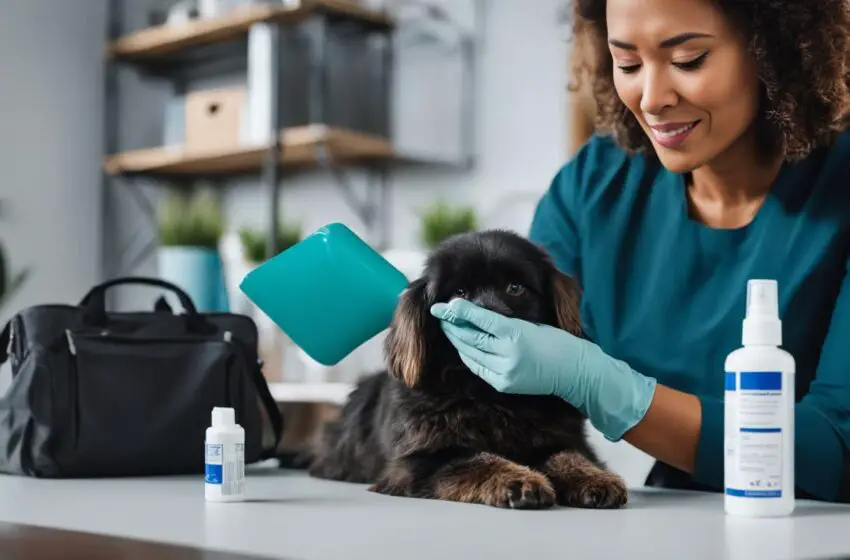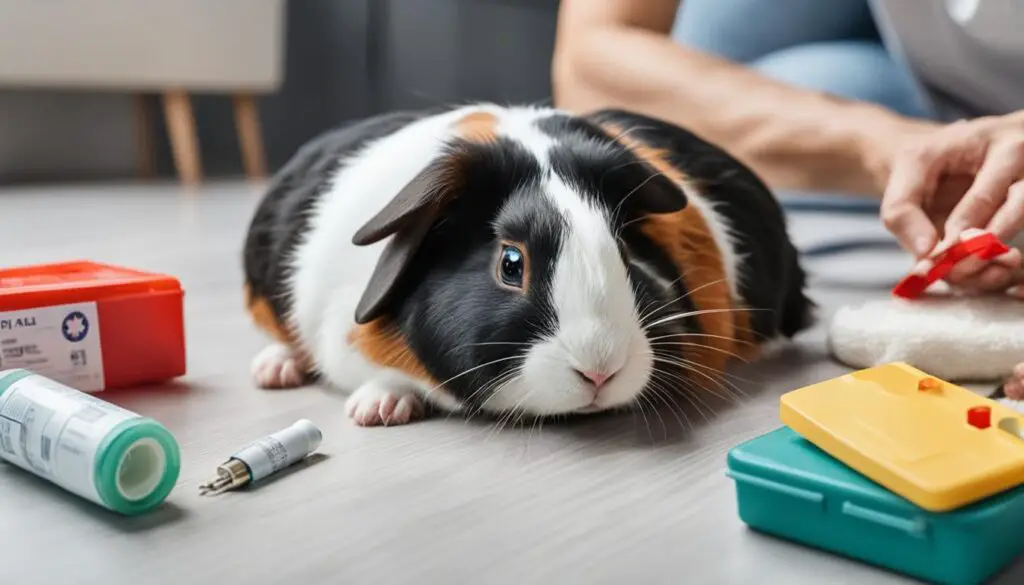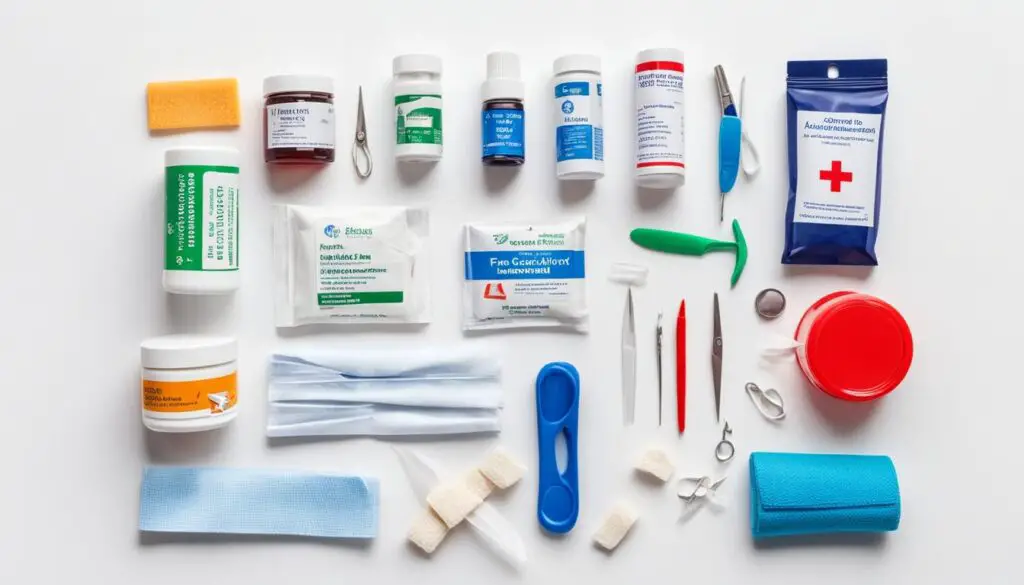First Aid Basics for Small Pet Owners

As a small pet owner, I understand the importance of being prepared for emergencies. Accidents or sudden illnesses can happen at any time, and knowing the basics of first aid can be the difference between life and death for our furry friends. In this article, I will guide you through the essential first aid techniques that every small pet owner should know.
Key Takeaways:
- First aid for small pets is crucial for pet owners to ensure their safety in emergencies.
- Immediate care can make a significant difference in the outcome for an injured or sick pet.
- Common first aid techniques for small pets include stopping bleeding, performing CPR, treating burns, and administering medication.
- A well-stocked first aid kit with essential supplies is a must-have for every pet owner.
- Being prepared and equipped can save lives and minimize the impact of common pet emergencies.
Importance of First Aid for Small Pets
First aid for small pets is of paramount importance when it comes to their safety during emergencies. Immediate care can be the determining factor in the outcome for an injured or sick pet. Knowing how to administer first aid can help stabilize their condition until professional veterinary care is available. As responsible pet owners, we must recognize the significance of being prepared and equipped to handle such emergency situations.
During unexpected emergencies, every second counts. Providing first aid promptly can alleviate pain, prevent further complications, and sometimes even save a pet’s life. Whether it’s a minor injury or a more serious medical condition, having the knowledge and skills to provide essential first aid can make a world of difference.
“In an emergency, your ability to act swiftly and confidently can be life-saving for your small pet.”
Consider this scenario: your small pet suddenly exhibits signs of distress, such as choking, bleeding, or difficulty breathing. The first few moments are critical, and being able to respond immediately can significantly impact the severity of the situation. With first aid knowledge, you can assess the situation, prioritize necessary actions, and effectively stabilize your pet’s condition until professional help arrives.
Furthermore, administering first aid to your small pet can help reduce their discomfort and anxiety during emergencies. By providing immediate care, you can alleviate pain, prevent further injury, and create a calmer environment for your pet, offering them the reassurance that they are in good hands.
Having a thorough understanding of first aid for small pets allows you to be proactive in caring for your beloved companion. It empowers you to take charge of their well-being and take immediate action during emergencies that may occur at any time, day or night.
Next, we will explore some common first aid techniques for small pets, providing you with the knowledge and skills necessary to handle different emergency situations effectively.

Table of Contents
- The Importance of First Aid for Small Pets
- Common First Aid Techniques for Small Pets
- First Aid Kit Essentials for Small Pets
- Handling Common Pet Emergencies
- Conclusion
Common First Aid Techniques for Small Pets
When it comes to the well-being of our small pets, knowing the common first aid techniques can make a significant difference in their safety and health. As responsible pet owners, we must be prepared to handle emergencies and provide immediate care when needed. Here are some essential techniques to keep in mind:
1. Stopping Bleeding
Accidents happen, and small pets can sometimes get injured, resulting in bleeding. To stop bleeding, apply gentle pressure to the wound using a clean cloth or gauze. Elevating the injured area can also help reduce blood flow. If bleeding persists or is severe, it is crucial to seek veterinary assistance.
2. Performing CPR
In emergency situations, performing CPR on a small pet can be life-saving. Cardiopulmonary resuscitation (CPR) involves providing chest compressions and artificial respiration. To perform CPR correctly, position your pet on a hard surface, locate the chest area, and apply pressure in a rhythmic manner. However, it is essential to receive proper training in pet CPR techniques before attempting them.
3. Dealing with Choking
Choking can pose a serious threat to small pets, obstructing their airways. If you suspect your pet is choking, try to remove the object causing the obstruction. You can perform the Heimlich maneuver by applying gentle pressure to the abdomen, just below the ribcage, with your hands. It’s crucial to remain calm and seek veterinary assistance if the choking persists.
4. Treating Burns or Wounds
Accidental burns or wounds can occur, requiring immediate attention. If your pet sustains a burn, gently cool the affected area with cool (not cold) water and apply a sterile dressing. Wounds should be cleaned with mild antiseptic solutions and covered with clean bandages. However, it’s essential to consult a veterinarian for further evaluation and appropriate treatment.
5. Administering Medication
Administering medication to small pets can be challenging, but it’s an essential part of their care. Whether it’s oral medication, eye drops, or topical creams, it’s crucial to follow the veterinarian’s instructions carefully. Using treats or specialized pet medication devices can make the process easier and less stressful for your furry friend.
By familiarizing ourselves with these common first aid techniques and having the necessary supplies readily available, we can be better equipped to handle emergencies and provide immediate care for our small pets.
“Knowing the common first aid techniques can make a significant difference in the safety and health of our small pets.”
First Aid Kit Essentials for Small Pets
A well-stocked first aid kit is an essential item for every small pet owner. Having the right supplies on hand can make a significant difference during emergencies, providing immediate care to your beloved furry friend. Here are some essential items that should be included in your pet’s first aid kit:
| Item | Description |
|---|---|
| Gauze | To clean and dress wounds |
| Adhesive tape | To secure bandages |
| Hydrogen peroxide | To induce vomiting (only under veterinary guidance) |
| Antiseptic wipes | To disinfect wounds |
| Bandages | To secure dressings and control bleeding |
| Tweezers | To remove splinters or ticks |
| Scissors | To cut bandages or adhesive tape |
| Digital thermometer | To monitor your pet’s temperature |
| Pet-friendly pain reliever | To provide temporary relief from pain |
It is crucial to regularly check and replenish the supplies in your pet’s first aid kit. Ensure that all items are within their expiration dates and in good condition. Store the kit in a easily accessible location, making it readily available during emergencies.

By having a well-prepared first aid kit, you can offer immediate and effective care to your small pet when it matters the most. Remember, quick action and proper supplies can make a significant difference in your pet’s well-being during emergencies.
Handling Common Pet Emergencies
Pet owners should always be prepared to handle common emergencies that small pets may encounter. Quick and effective first aid can be crucial in preventing further harm and ensuring the well-being of your furry friends. Here are some of the most common pet emergencies and the appropriate first aid techniques to employ:
- Choking: If your small pet is choking, gently restrain them and try to locate and remove the obstruction from their airway. Be cautious not to push the object further down. If the obstruction cannot be dislodged, seek immediate veterinary assistance.
- Poisoning: If you suspect your small pet has ingested something toxic, contact your veterinarian immediately. Do not induce vomiting without professional guidance as some substances can cause more harm if regurgitated.
- Heatstroke: In case of heatstroke, move your pet to a cool, shaded area and apply cool water to their fur, focusing on the head, neck, and belly. Use a fan if available. It’s crucial to gradually lower their body temperature and seek veterinary attention.
- Seizures: During a seizure, keep your small pet away from potentially harmful objects and ensure they have enough space to move safely. Do not try to restrain or hold them down. Make note of the seizure duration and characteristics for your veterinarian.
- Injuries: If your small pet sustains an injury such as a wound or fracture, apply gentle pressure to stop any bleeding and cover the wound with a clean cloth or bandage. Prevent unnecessary movement and transport your pet to the veterinarian.
- Sudden Illnesses: If your pet displays sudden signs of illness such as difficulty breathing, vomiting, or loss of consciousness, it is essential to contact your veterinarian immediately for guidance and take necessary first aid steps while awaiting professional help.
Remember, it is essential to stay calm and composed when handling a pet emergency. Assess the situation, provide the necessary care promptly, and always seek veterinary assistance whenever needed.
| Emergency | First Aid Technique |
|---|---|
| Choking | Attempt to remove the obstruction without pushing it further down. Seek veterinary assistance if necessary. |
| Poisoning | Contact your veterinarian immediately. Avoid inducing vomiting without professional guidance. |
| Heatstroke | Move your pet to a cool area and cool them down gradually with water. Seek veterinary attention. |
| Seizures | Ensure a safe environment, away from hazards. Note seizure details for your veterinarian. |
| Injuries | Apply pressure to stop bleeding and cover wounds. Transport to the veterinarian. |
| Sudden Illnesses | Contact your veterinarian immediately. Provide immediate care while awaiting professional help. |
Conclusion
In conclusion, first aid for small pets is an essential aspect of responsible pet ownership. Being prepared and equipped with the necessary knowledge and supplies can significantly impact providing immediate care during emergencies. By following the basic first aid techniques and having a well-stocked first aid kit, pet owners can ensure the safety and well-being of their furry companions.
Remember, taking proactive measures in emergency preparedness can save lives. Understanding how to deal with common emergencies such as choking, poisoning, heatstroke, seizures, injuries, and sudden illnesses is crucial. Pet owners should remain calm, assess the situation, and promptly provide the necessary care to minimize the impact on their pet’s health.
By prioritizing first aid for small pets, pet owners demonstrate their commitment to their pets’ care and well-being. Whether it’s stopping bleeding, performing CPR, treating burns or wounds, or administering medication, having the knowledge and skills to provide immediate assistance can be lifesaving. Furthermore, regularly checking and replenishing the supplies in the first aid kit ensures its effectiveness in times of need.
In summary, small pets rely on their owners for care and protection. Being knowledgeable in first aid and having a well-stocked first aid kit should be an integral part of every pet owner’s emergency preparedness plan. By taking these actions, pet owners become empowered to handle emergencies and provide immediate care, ultimately safeguarding their furry friends’ health and happiness.
FAQ
What is first aid for small pets?
First aid for small pets involves providing immediate care and stabilization to injured or sick pets until professional veterinary care is available.
Why is first aid important for small pets?
First aid is important for small pets as it can make a significant difference in their outcome during emergencies. It helps stabilize their condition and minimizes the impact on their health.
What are some common first aid techniques for small pets?
Common first aid techniques for small pets include stopping bleeding, performing CPR, dealing with choking, treating burns or wounds, and administering medication.
What should be included in a first aid kit for small pets?
A well-stocked first aid kit for small pets should include gauze, adhesive tape, hydrogen peroxide, antiseptic wipes, bandages, tweezers, scissors, a digital thermometer, and a pet-friendly pain reliever.
What are some common pet emergencies that small pets may encounter?
Common pet emergencies for small pets include choking, poisoning, heatstroke, seizures, injuries, and sudden illnesses.
How can pet owners handle common pet emergencies?
Pet owners can handle common pet emergencies by staying calm, assessing the situation, and providing the necessary first aid care promptly.
Why is emergency preparedness important for small pet owners?
Emergency preparedness is important for small pet owners as it ensures their ability to provide immediate care during emergencies, potentially saving their pet’s life.
Source Links
- https://www.wspa.com/news/national/an-expensive-meal-pennsylvania-family-dog-eats-4000-off-the-counter/
- https://indianapolis43.heatherridercoaching.com/web-stories/7-essentials-for-a-safe-trip-while-travelling-with-a-puppy/
- https://www.bigcountryhomepage.com/news/national-news/ap-blinken-meets-jordans-king-and-foreign-minister-on-mideast-push-to-keep-gaza-war-from-spreading/



